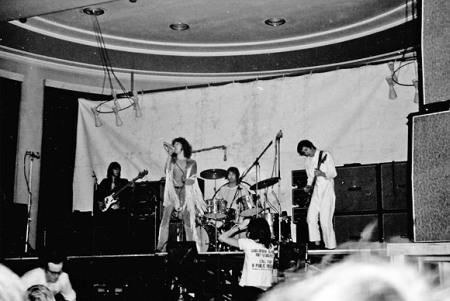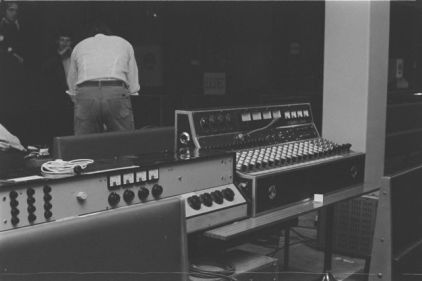The Who at Leeds University Refectory, 14 February 1970
Details of the Who’s show at Leeds University Refectory, 14 Feb. 1970, compiled with Luke P.
‘The best live rock album ever made’
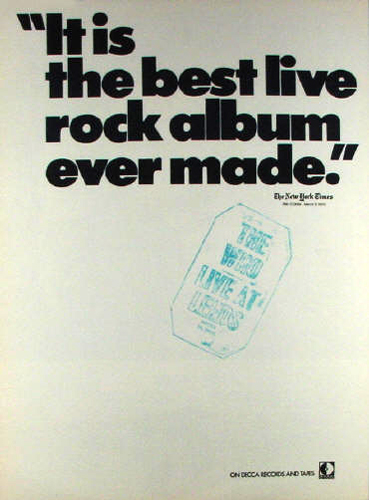
Photo via The Who This Month
On 14 Feb. 1970, The Who performed the first of two University dates for the purpose of recording a live album, having lost the patience to sort through the tapes recorded on the North American 1969 tour. The first gig, at the University Refectory at the University of Leeds, in front of an audience of 2,000, showcased The Who’s live act at its finest.
Both Leeds and Hull City Hall the following night were professionally recorded by the Pye Mobile Recording Unit. Subsequent production, mixing and editing — including vocal overdubs — were done at Pye or Eel Pie (Pete’s home studio) prior to the album being released on 16 May 1970 on Decca in the U.S. and on 23 May 1970 on Track in the U.K., in a sleeve designed to mimic a bootleg, and included copies of Who memorabilia, contracts, photos and a Maximum R&B poster. The label also famously noted “Crackling Noises O.K. Do Not Correct!” It reached #4 in the U.S. charts and #3 in the U.K.
While the original album featured only six songs, half of which were cover versions, albeit what would become the definitive cover versions, expanded reissues subsequently released starting in 1995 featured most of the entire show, though certain edited portions of songs still remained unreleased. And the full Hull recording, the recording of which was missing the bass track on the first songs, was also subsequently released in 2010.
The audio quality of the recording, despite the “crackling noises,” features a sound quality — and sound stage — that invites the listener to imagine being in that Refectory on Valentine’s Day 1970. With bass panned left, guitar panned right, but plenty of bleed to the left (whether thanks to the WEM Copicat or the cafeteria walls), vocals and drums down the middle, the “Leeds” sound perfectly captures, warts and all, the band at its peak of the Tommy era.
Live at Leeds – The album
Original version. Remastered 1995 version with full set list below. For 2001 Deluxe Edition, see Compilations.
- Originally released:
- UK (Track), 16 May 1970 [#3 (21)]
- US (Decca), 23 May 1970 [#4 (44)]
- Young Man Blues
- (bass)
- Substitute
- Summertime Blues
- (bass)
- Shakin’ All Over/Spoonful
- My Generation (live medley)
- (bass)
- Magic Bus (live)
- (bass)
Remastered 1995 version with full set list (see Tommy – for guitar and Tommy – for bass complete for complete Tommy selections). Tracks in bold indicate original 1971 track listing. For 2001 Deluxe Edition, see Compilations.
- Heaven And Hell (live)
- I Can’t Explain (Live)
- (bass)
- (drums
- (studio version)
- Fortune Teller
- (bass)
- Tattoo
- (bass)
- Young Man Blues
- (bass)
- Substitute
- Happy Jack
- (bass)
- I’m A Boy
- A Quick One, While He’s Away (live)
- (bass – live)
- (drums)
- Amazing Journey
- Sparks (live)
- See Me Feel Me (live)
- Summertime Blues
- (bass)
- Shakin’ All Over/Spoonful
- My Generation (live medley)
- (bass)
- Magic Bus (live)
- (bass)
The “Leeds” sound
Instrumentation used on this performance.
Guitar:
Pete used his standard setup for 1969–70, with a cherry red Gibson SG Special with one spare, two Hiwatt CP103 amps with one in spare, driving four Hiwatt SE4123 4×12 cabinets (with bottoms likely dummies), with a U-1093 Univox Super Fuzz pedal. An additional CP103 and 4×12 was set up at stage right for foldback.
Bass:
John used his Fender “Frankenstein” Precision Bass, and two Hiwatt CP103 amps driving four Hiwatt SE4122 or SE4123 4×12 speaker cabinets. An additional 4×12 was set up at stage left for foldback.
Drums:
Keith used his Premier Champagne Silver kit, which was retired after the Hull gig the following night.
PA:
The PA for the Leeds University gig, in a cafeteria hall, was the WEM PA the Who had used since 1969, with WEM Audiomaster PA mixers, powered by WEM PA100 100-watt amps, and with WEM Copicat echo.
FOH speakers: three Marshall 8×10 cabinets per side; four WEM 4×12 columns per side, and one WEM 2×15 cabinet per side.
Foldback speakers: two WEM cabinets and one WEM PA column per side, set on chairs on platforms recessed below the stage.
Microphones for FOH were Shure 565. The PA system consisted of at least 11 Shure 565 mics: one for John’s bass amp, one for Pete’s guitar amp, one for each of the three vocalists, one for each of the two kick drums, and at least four more for the rest of the drum kit. See below for further details.
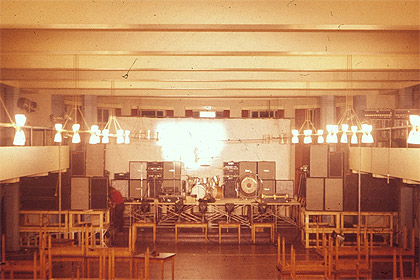
Click to view larger version (3.5mb). 14 Feb., 1970 – Leeds University Refectory, showing WEM/Marshall PA setup for small hall. Features three Marshall 8×10 cabs per side, and four WEM 4×12 columns per side, and one WEM 2×15 cabinet per side. Photo © and courtesy: John Standerline, Leeds University Union Entertainments Committee, 1967–1970.
The Who Live At Leeds recording
Essay by Luke P. (Lukpac) on The Who’s microphones and recording for the Leeds gig, reprinted with permission.
The Who had recorded their fall 1969 US tour live to stereo with the intention of issuing a live album from the tapes, but upon returning to England, Pete Townshend was overwhelmed by the prospect of going through dozens of hours of tapes and scrapped the idea. As an alternative, the Pye Mobile Recording Unit was booked to record the band’s shows in Leeds on 14 February and Hull on 15 February, 1970.
Pye was one a few recording studios at the time in the UK with mobile recording capabilities, but it wouldn’t be until 1971 that they had a “control room on wheels” similar to the Rolling Stones Mobile Studio (which first went into operation in 1970) or the Ronnie Lane Mobile Studio (which followed in 1972). At the time Pye had two transport vehicles which were just a means of getting the recording gear to the venue, at which point it would be hauled inside and set up.
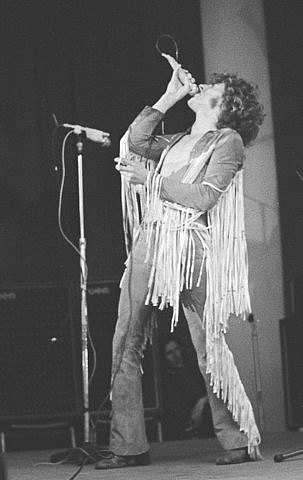
14 Feb. 1970, at Leeds University Refectory, WEM foldback columns on chairs visible at stage right.
In the case of Leeds, the site of the makeshift control room was the “backstage” area a level down from the refectory where the stage was set up. Variously described in articles about Live At Leeds as a kitchen or a cloakroom, it was actually another restaurant. John Standerline, who helped put on the show as a member of the university’s Entertainments Committee, describes the location:
“The recording equipment had to go downstairs as there was not enough power on the upper level. The University Refectory was where concerts were held (Hops as they were known then) and by 1970 we had had a substantial permanent stage purchased which filled the semi circular windowed section at one end of the building. When both seating areas of the refectory were opened up and cleared of tables, you could get 2,000 people in. The recording equipment was located down stairs in another restaurant called the Gryphon Grill — there was slightly more upmarket food there. The power for the recording equipment came from the kitchen of that restaurant hence the confusion. A set of stairs from the side of the main stage went down to the Gryphon Grill hence it was used as a base for bands to change etc before a show with easy access to the stage.”
The crew recording the show consisted of the following Pye staff:
- Vic Maile – chief recording engineer
- Neville Crozier – assistant engineer
- Alan Perkins – tape operator
- Terry Yeadon – technical/maintenance engineer
However, as Neville Crozier notes, The Who’s concert in Leeds wasn’t the only show on the docket that day:
“In the morning [of February 14th], Vic Maile and I drove one van to Bingley, I think, to set up a two-track system to record the Hammonds Sauce Works brass band. Vic then went over to Leeds, to help set up for The Who’s recording, whilst I recorded the brass band. I then drove to Leeds, before the concert, where Alan Perkins, Terry Yeadon and Vic were already assembling the equipment. We were all staying in Bradford, which was in-between the two recordings.”
The recording equipment at Leeds consisted of a 3M M23 8-track tape machine, a custom 12x3 mixer known as the “Smellotron”, a custom 16x4 mixer with nuvistor electronics, and Tannoy speakers in Lockwood cabinets. Pye engineer Philip Newell, who started a few months after Leeds (and worked on the recording of The Who at the “Goodbye Summer” concert at the Oval Cricket Ground, in September 1971), describes the custom mixers:
“The Smellotron was made from three, mono, 4-input, Vortexion, valve, microphone mixers bolted together, with added echo sends and returns, metering, and a very crude monitoring arrangement. It was initially made for use with half-inch, three-track tape recorders. There was no equalisation, but up to four microphones could be mixed to each of the three tracks, and the monitoring sent the left mixer output (buffered from the main out) to the left monitor loudspeaker, the right output to the right loudspeaker and the centre output split between both.”
“Incidentally the mixer was called the Smellotron (a portmanteau word) because of the fashionable use of Mellotrons at the time, and because it had been assembled in the workshop by Steve Muirfield, who was notorious for endlessly telephoning companies to ask for brochures about recording equipment. At the time, David Hawkins (the current owner of Eastlake Audio, which he bought from Tom Hidley) who worked at Pye for a few years in the late 1960s after leaving the pirate-radio ship, Radio London, tired of the endless piles of publicity material gathering in the workshop, so he decided to phone up some companies, impersonating Steve, but pronouncing his surname as Man-yur-field. He would then spell it out to the person on the telephone as m-a-n u-r-e f-i-e-l-d. Soon afterwards, letters then began arriving at the studios addressed to Stephen Manurefield, which, everyone automatically pronounced manure-field, hence he often became referred to as “Smelly” — a name that was soon blended with Mellotron.”
“The nuvistor mixer was built at Pye studios, with the circuitry based around the Ampex MR70 tape recorder electronics. Pye had an MR70, which used nuvistors instead of vacuum tubes (valves) and it sounded great. So; Ken Attwood, the head of maintenance at Pye, decided to build a 16/4 mixer for the mobile, using similar circuitry. In 1971, Jimmy Page bought it off Pye, after hearing the recordings made with it of the Royal Albert Hall concerts of Led Zeppelin. Everybody loved that mixer, but a few months after Leeds, Pye bought a 24/8 Neve Series 80 for the mobile (split into three “portable” sections — weighing about 400 lbs each). This was used at the Isle of Wight festival.”
The two mixers offered a combined 7 main outputs. Memories are hazy over how an 8th output would have been effected, although it’s possible that an aux buss of the nuvistor mixer could have been utilized for such a purpose.
Standard practice for live recording at the time was to use two tape machines: as a reel of tape could only hold about 32 minutes of audio, a second tape machine would be started before the reel on the first machine ran out to ensure there was no gap in the recording. However, at Leeds only one tape machine was used, which meant that the crew had to coordinate reel changes with the band. Neville Crozier explains:
“Not sure why we only used one recorder, I’m sure we had two, maybe one was in repair, these were still early days for live recording, so had to make it up as we went along! For the tape change over, I would think we just signalled to a roadie by the stage, which is probably the voice you can hear, any reference to a red light I would think was just Pete making it easy for the audience to understand. The point in the show to stop for a reel change would have been agreed with the band beforehand.”
Another possible reason for only using a single tape machine was budget: according to Philip Newell, “I think that it was considerably more expensive to hire the mobile if we used two machines. At that time, each M23 cost the same to buy as a four-bedroomed house in Croydon.”
As time was of the essence, when it came time to change reels the Pye engineers would stop the tape and lift both reels off the tape machine, without winding the tape to the end of the reel. And they were quite successful: at Leeds only about 15 seconds was lost at each reel change. The show was recorded onto nine reels of 1″ 8-track tape, as follows:
- “Heaven And Hell” through “Tattoo”
- “Young Man Blues” through “I’m A Boy”
- “A Quick One, While He’s Away”
- “Overture” through “Sparks”
- “Eyesight To The Blind” through “Pinball Wizard”
- “Do You Think It’s Alright?” through “We’re Not Gonna Take It”
- “Summertime Blues” and “Shakin’ All Over”
- “My Generation”
- “Magic Bus”
Two sets of microphones were used at the show, one for the PA and one for recording. The PA system consisted of at least 11 Shure 565 mics: one for John’s bass amp, one for Pete’s guitar amp, one for each of the three vocalists, one for each of the two kick drums, and at least four more for the rest of the drum kit. With the exception of Roger’s vocal mic, however, the mics used for the PA were completely different from those used for the recording, which were as follows:
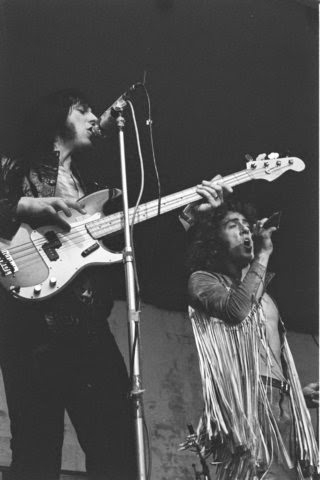
14 Feb. 1970, at Leeds University Refectory, with John’s microphone stand with a Shure 565 and an AKG D-224E affixed above.
- John vocal: AKG D-224E, taped to his Shure 565. This mic was also used by Roger at times, notably when he was playing tambourine, as there was no stand for his mic.
- Roger vocal: The same Shure 565 used for the PA, split to also feed the recording.
- Pete vocal: AKG D-224E, taped to his Shure 565.
- bass amp: Neumann U67.
- guitar amp: Neumann U67.
- kick drum 1: Neumann U67.
- kick drum 2: Neumann U67.
- drum kit 1: AKG D-224E, angled down towards Keith a few inches above the floor toms stage right.
- drum kit 2: AKG D-224E, angled down towards the snare, about 1.5′ from the snare, and more or less between the two rack toms on that side of the kit (stage left).
- audience: A Neumann SM2, hung over the balcony, house right, about one third of the way back from the stage.
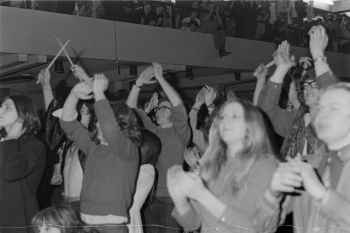
Click to view larger version. 14 Feb. 1970, Leeds University Refectory, crowd view, with audience microphone hanging from its lead from the upper level.
Engineer Alan Perkins recalls taping an AKG D-224E to Roger’s vocal mic before the show for recording purposes, but both the prospect of two mics flying through the air and the AKG mic’s relative fragility must have caused second thoughts, as by showtime only the Shure 565 was present, with the cable coiled and taped to the body to allow for safe microphone acrobatics.
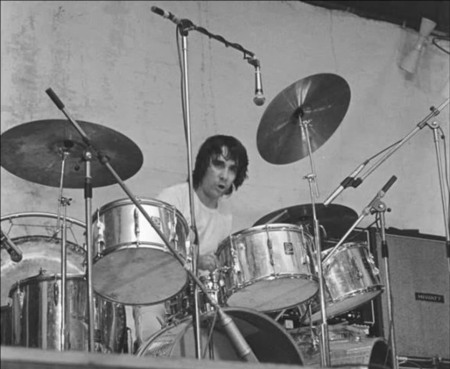
14 Feb. 1970, Leeds University Refectory, with Champagne Silver Premier kit, as heard on Live at Leeds.
The fairly minimal drum kit mic setup was unique but yielded superlative results. Neville Crozier:
“The drum mic positions were something Vic had come up with over time, the usual high overheads would pick up too much guitar etc, so he kept lowering them down until he got the best sound. Vic is remembered as one of the best live sound engineers of that era, I always think how lucky I was to work and learn from him.”
Each of the 10 microphones were recorded to their own track on the 8-track tapes, except for the drum mics: the two kick drum mics were mixed together on one track and the two drum kit mics were mixed together on another track.
For as good as the recording was, it was plagued by now infamous crackling noises throughout. Neville Crozier describes the crew’s frustration during the show:
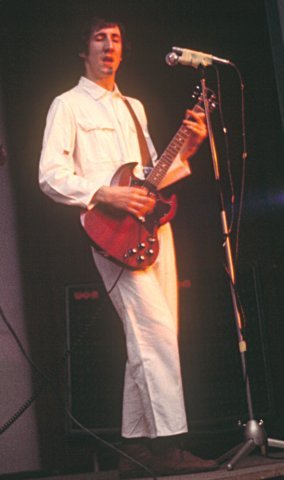
14 Feb. 1970 – Leeds University, WEM foldback columns on chairs visible at right, and Pete’s Shure 565 mic with AKG D-224E affixed above.
“They came about when during the recording we noticed that if any of us sat on the bench in front of the mixers a “Crack” occurred. Well, as you can imagine, we didn’t think it possible, so we kept trying it, me included, and sure enough it happened every time, so for the rest of the show we just kept clear of it, however we later found out it had gone on to the tape. It was probably some sort of static, so no great technical answer, just one of those simple things that has now gone into history [on the labels of the discs, which are marked — “Crackling Noises O.K. Do Not Correct!”].”
The exact source of the noises is still a mystery, although it’s possible they originated from the tube (“valve” in British English) condenser mics used on the amps, kick drums, and audience, all of which required an external source of power.
The recording was not over when the last echoes of “Magic Bus” died away, however. Upon reviewing the tapes, the band decided to re-record some vocals, which occurred at Pye Studios. Pete Townshend indicated in his autobiography that the reason for this was the backing vocals hadn’t been recorded correctly. However, rough mixes of “Happy Jack” and “I’m A Boy” with the original concert vocals (available on bootlegs) suggest the issue was simply that the live vocal performances were felt to be a bit rough. The overdubs primarily consisted of John and Pete’s backing vocals, but Roger also re-recorded his “See me, feel me, touch me, heal me” line during “My Generation”. The backing vocals on “Happy Jack”, “I’m A Boy”, and “My Generation” were definitely re-recorded, and it’s likely that those on a few other songs, notably “I Can’t Explain” and “Substitute”, were as well. John and Pete’s overdubs erased their original live vocals, but Roger’s “My Generation” overdub was recorded on the track otherwise used for Pete’s vocal, so the live and overdubbed vocals exist side by side in that case.
Many thanks to Neville Crozier, Philip Newell, Alan Perkins, John Standerline and John Rettie for all of their help and insights.
—LP, July/September 2019
Photo Gallery
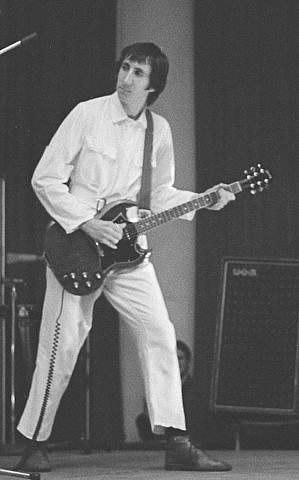
14 Feb. 1970 – Leeds University, WEM foldback column on chair visible at right.
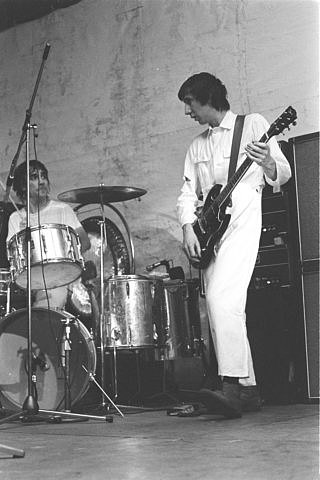
14 Feb. 1970, Leeds University, stage setup of Pete’s rig, one customised Hiwatt DR103 and two CP103 amps with four Hiwatt 4×12 cabs. Guitar is SG Special, and pedal is Univox Super-Fuzz.
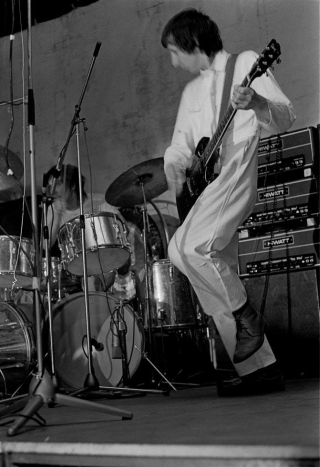
Click to view larger version. 14 Feb. 1970, Leeds University, stage setup of Pete’s rig, one customised Hiwatt DR103 and two CP103 amps with four Hiwatt 4×12 cabs. Guitar is SG Special, and pedal is Univox Super-Fuzz. Coil cable from the pedal is wound around the top amp handle, and connected to a splitter, leading to the two active amplifier inputs.
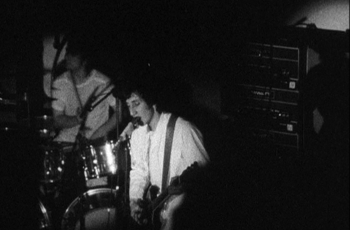
14 Feb. 1970, Leeds University, stage setup of Pete’s rig, one customised Hiwatt DR103 and two CP103 amps with four Hiwatt 4×12 cabs. Guitar is SG Special.
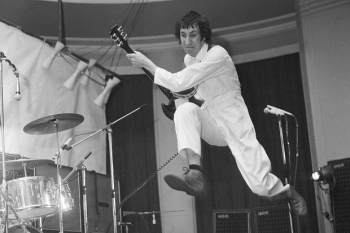
Click to view larger version. 14 Feb. 1970, Leeds University, stage setup of Pete’s rig, one customised Hiwatt DR103 and two CP103 amps with four Hiwatt 4×12 cabs. Guitar is SG Special.
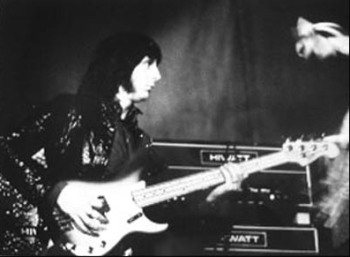
14 Feb. 1970, at Leeds University Refectory, with “Frankenstein” and Hiwatts.
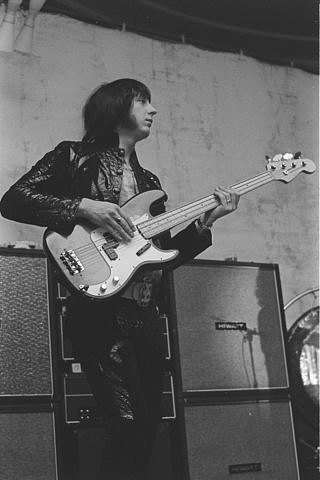
14 Feb. 1970, at Leeds University Refectory, with “Frankenstein” and Hiwatts.
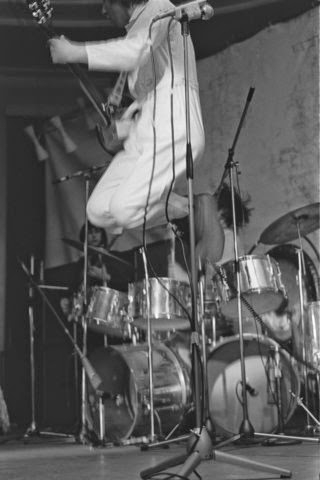
14 Feb. 1970, Leeds University.
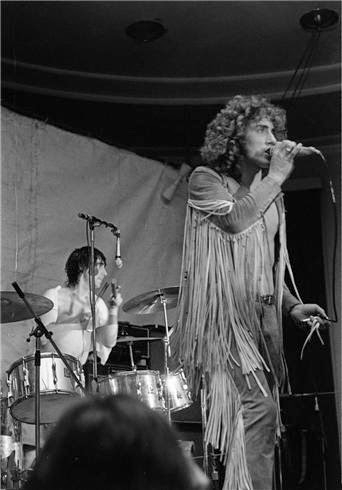
14 Feb. 1970, Leeds University, performing Magic Bus.
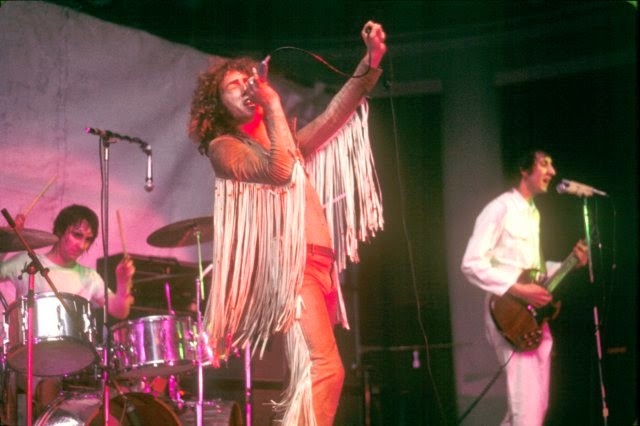
14 Feb. 1970, Leeds University.
- Return to the main 1969–70 PA page.
- Return to the main gear page
Acknowledgements
- Many thanks to Luke P for assistance, contributions and corrections to this page.
